Phase Change Tracking Approach to Predict Timing of Condensate Formation and Its Distance from the Wellbore in Gas Condensate Reservoirs
Abstract
:1. Introduction
2. Model Description and Methodology
- Evaluate the fluid composition of C1 and C4-6 as a function of time for each optimization technique to determine the phase behaviour and changes of production components over time.
- Determine the condensate saturation build-up in the reservoir as a function of time for each grid block under different optimization techniques.
- Compare the composition of fluid components (C1 & C4-6) with the reservoir pressure to evaluate the effect of pressure upon the condensate formation.
2.1. Gas Condensate Reservoir Model Characterization
2.2. Methods to Track Phase Change in the Reservoir
3. Results and Discussions
3.1. Tracking the Changes in Gas Compositions during Reservoir Depletion
3.2. Tracking Saturation Phase Change and Its Distance from the Wellbore
3.3. Three-Dimensional (3D) Representation of Phase Change During Condensate Production
4. Conclusions
- This study gives a better understanding of hydrocarbon phase change and behaviour in the reservoirs by tracking the timing of change and distance from the wellbore. This enables the production engineer to gain a better understanding of the situation for reservoir management and plan a suitable optimization technique for future production.
- The phase tracking approach that was used for the investigation of the gas condensate reservoir performance has not been used to evaluate gas condensate recovery in any previous study.
- A compositional study of gas condensate fluid flow was conducted to track the change in the composition of hydrocarbons, specifically C1 and C2-6 representing light and intermediate gas components during the production life of gas condensate reservoirs.
- Several scenarios were considered to validate the proposed technique and to determine the time of condensate banking as well as its distance from a well. This was also used as a guide to optimize condensate production. Typical scenarios such as water injection and gas recycling were also considered in studying condensate banking in this study.
- The results indicate that the further the distance away from the vicinity of the wellbore, the lower the effect of pressure drop on the cell grid. Cells closer to the wellbore experience the effect of pressure drop earlier as compared with the other cells. The liquid dropout is immobile until the critical saturation point is reached.
- To optimize the production from gas condensate reservoirs, the length and timing of region 3 need to be enhanced. In other words, the single-phase system in the reservoir needs to be extended. The application of water injection in regions 1 and 2 resulted in the highest condensate production amongst all other scenarios.
Author Contributions
Funding
Acknowledgments
Conflicts of Interest
References
- Fevang, O.; Whitson, C. Modeling gas-condensate well deliverability. SPE Reserv. Eng. 1996, 11, 221–230. [Google Scholar] [CrossRef]
- Mott, R. Calculating well deliverability in a gas condensate reservoir. In Proceedings of the EAGE—10th European Symposium on Improved Oil Recovery, Brighton, UK, 18–20 August 1999. [Google Scholar]
- Mott, R. Engineering calculation of gas condensate well productivity. Presented at the SPE Annual Technical Conference and Exhibition, San Antonio, TX, USA, 29 September–2 October 2002. [Google Scholar]
- Gringarten, A.; Al-lamki, A.; Daungkaew, S.; Mott, R.; Whittle, T. Well test analysis in gas-condensate reservoirs. Presented at the SPE Annual Technical Conference and Exhibition, Dallas, TX, USA, 1–4 October 2000. [Google Scholar] [CrossRef]
- Whitson, C.H.; Fevang, O.; Sævareid, A. Gas condensate relative permeability for well calculations. Presented at the SPE Annual Technical Conference and Exhibition, Houston, TX, USA, 3–6 October 2003. [Google Scholar] [CrossRef]
- Xiao, J.J.; Al-Muraikhi, A.J. A new method for the determination gas condensate well production performance. Presented at the SPE Annual Technical Conference and Exhibition, Houston, TX, USA, 26–29 September 2004. [Google Scholar]
- Shi, C.; Horne, R.N.; Li, K. Optimizing the productivity of gas condensate wells. Presented at the 2006 SPE Annual Technical Conference and Exhibition, San Antonio, TX, USA, 24–27 September 2006. [Google Scholar]
- Shi, C.; Horne, R.N. Improved recovery in gas-condensate reservoirs considering compositional variations. Presented at the SPE Annual Technical Conference and Exhibition, Denver, CO, USA, 21–24 September 2008. [Google Scholar] [CrossRef]
- Shi, C. Flow Behaviour of Gas-Condensate Wells. Ph.D. Thesis, Stanford University, Stanford, CA, USA, 2009. [Google Scholar]
- Seah, Y.H.; Gringarten, A.C.; Giddins, M.A.; Burtons, K. Optimizing recovery in gas condensate reservoirs. Presented at the SPE Asia Pacific Oil and Gas Conference, Adelaide, Australia, 14–16 October 2014. [Google Scholar]
- Ahmadi, M.; Sharifi, M.; Hashemi, A. Comparison of simulation method in gas condensate reservoirs. Pet. Sci. Technol. 2014, 32, 761–771. [Google Scholar] [CrossRef]
- Shi, J.; Huang, L.; Li, X.; Sepehrnoori, K. Production forecasting of a gas condensate well considering fluid phase behaviour in the reservoir and wellbore. J. Nat. Gas Sci. Eng. 2015, 24, 279–290. [Google Scholar] [CrossRef]
- Muskat, M. Condensate Reservoirs in Physical Principles of Oil Production, 1st ed.; McGraw-Hill Book: New York, NY, USA, 1949; pp. 738–809. [Google Scholar]
- O’Dell, H. Successfully cycling a low-permeability, high-yield gas condensate reservoir. J. Pet. Technol. 1967, 19, 41–47. [Google Scholar]
- Roebuck, I.F.; Henderson, G.E.; Doughlas, J. The composition reservoir simulator: Case IV—The Two-Dimensional model. Presented at the SPE Annual Fall Meeting, Houston, TX, USA, 29 September–2 October 1968. [Google Scholar]
- Fussell, D. Single-well performance predictions for gas condensate reservoirs. J. Pet. Technol. 1973, 25, 860–870. [Google Scholar] [CrossRef]
- Bourbiaux, B.J.; Limborg, S.G. An integrated experimental methodology for a better prediction of gas condensate flow behaviour. Presented at the SPE Annual Technical Conference and Exhibition, New Orleans, LA, USA, 25–28 September 1994. [Google Scholar]
- Kalaydjian, J.M.; Bourbiaux, B.J.; Lombard, J.M. Predicting gas-condensate reservoir performance: How flow parameters are altered when approaching production wells. Presented at the SPE Annual Technical Conference and Exhibition, Denver, CO, USA, 6–9 October 1996. [Google Scholar]
- Fevang, O. Gas Condensate Flow Behaviour and Sampling. Ph.D. Thesis, Norwegian Institute of Technology, Trondheim, Norway, 1995. [Google Scholar]
- Penuela, G.; Civan, F. Gas-condensate well test analysis with and without relative permeability curves. Presented at the SPE Annual Technical Conference and Exhibition, Dallas, TX, USA, 1–4 October 2000. [Google Scholar] [CrossRef]
- Roussennac, B. Gas Condensate Well Test Analysis. Master’s Thesis, Stanford University, Stanford, CA, USA, 2001. [Google Scholar]
- Wheaton, R.J.; Zhang, H.R. Condensate banking dynamics in gas condensate fields: Compositional changes and condensate accumulation around production wells. Presented at the SPE Annual Technical Conference and Exhibition, Dallas, TX, USA, 1–4 October 2000. [Google Scholar]
- Ayala, L.F.; Ertekin, T. Analysis of Gas Cycling Performance in Gas/Condensate Reservoirs Using Neuro-Simulation. Presented at the SPE Annual Technical Conference and Exhibition, Dallas, TX, USA, 9–12 October 2005. [Google Scholar]
- Shams, B.; Yao, J.; Zhang, K.; Zhang, L. Sensitivity analysis and economic optimization studies of inverted five-spot gas cycling in gas condensate reservoir. IOP Conf. Ser. Earth Environ. Sci. 2017, 15, 525–535. [Google Scholar] [CrossRef]
- Wang, M.; Chen, S.; Lin, M. Enhancing recovery and sensitivity studies in an unconventional tight gas condensate reservoir. Pet. Sci. 2018, 15, 305–318. [Google Scholar] [CrossRef]
- Su, Z.; Tang, Y.; Ruan, H.; Wang, Y.; Wei, X. Experimental and modeling study of CO2-Improved gas recovery in gas condensate reservoir. Petroleum 2017, 3, 87–95. [Google Scholar] [CrossRef]
- Qiu, X.; Tan, S.P.; Dejam, M.; Adidharma, H. Simple and accurate isochoric differential scanning calorimetry measurements: Phase transitions for pure fluids and mixtures in nanopores. Phys. Chem. Chem. Phys. 2019, 21, 224–231. [Google Scholar] [CrossRef] [PubMed]
- Qiu, X.; Tan, S.P.; Dejam, M.; Adidharma, H. Novel isochoric measurement of the onset of vapor-liquid phase transition using differential scanning calorimetry. Phys. Chem. Chem. Phys. 2018, 20, 26241–26248. [Google Scholar] [CrossRef] [PubMed]
- Kenyon, D. Third SPE comparative solution project: Gas cycling of retrograde condensate reservoirs. J. Pet. Technol. 1987, 39, 981–997. [Google Scholar] [CrossRef]
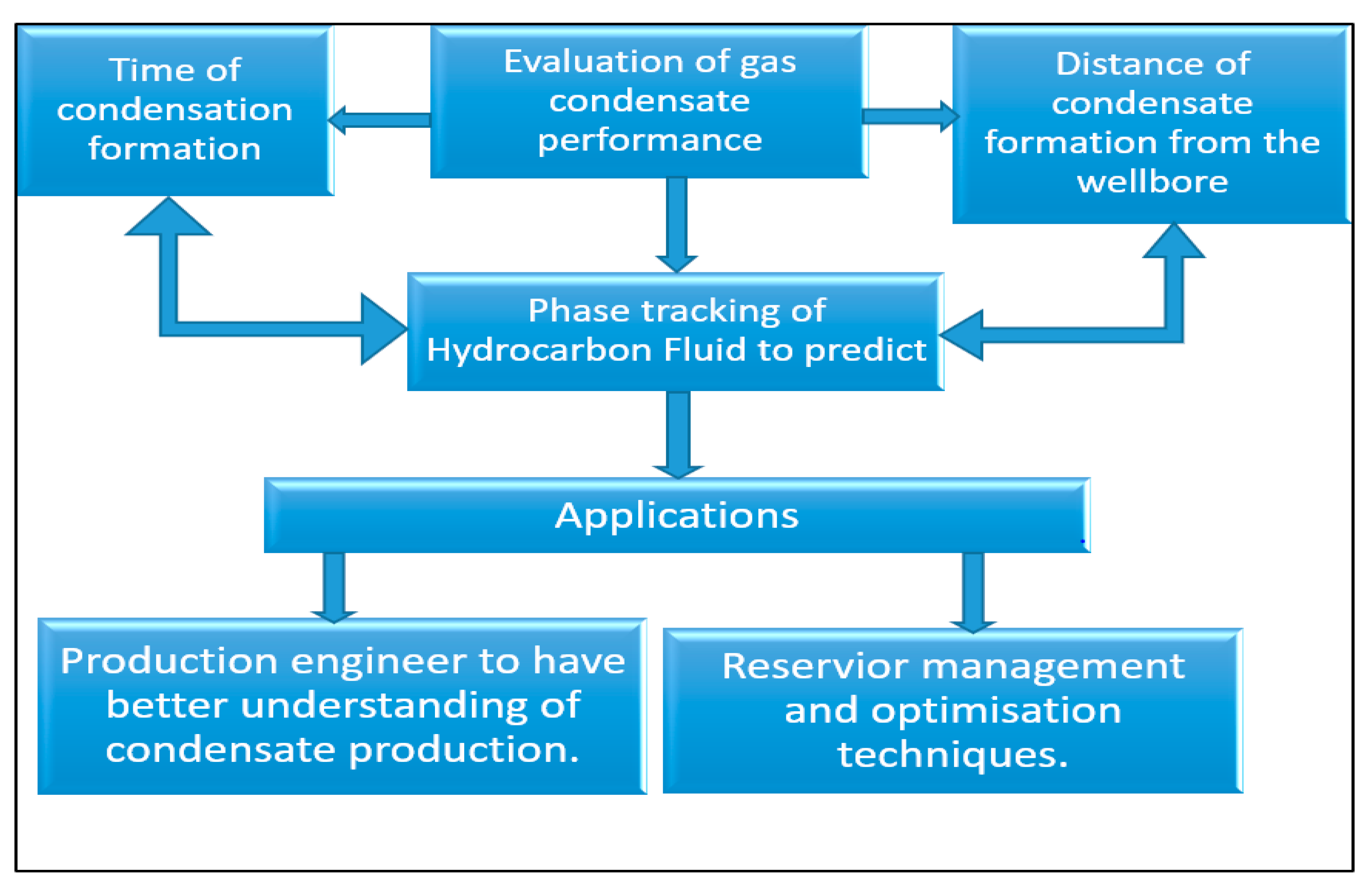
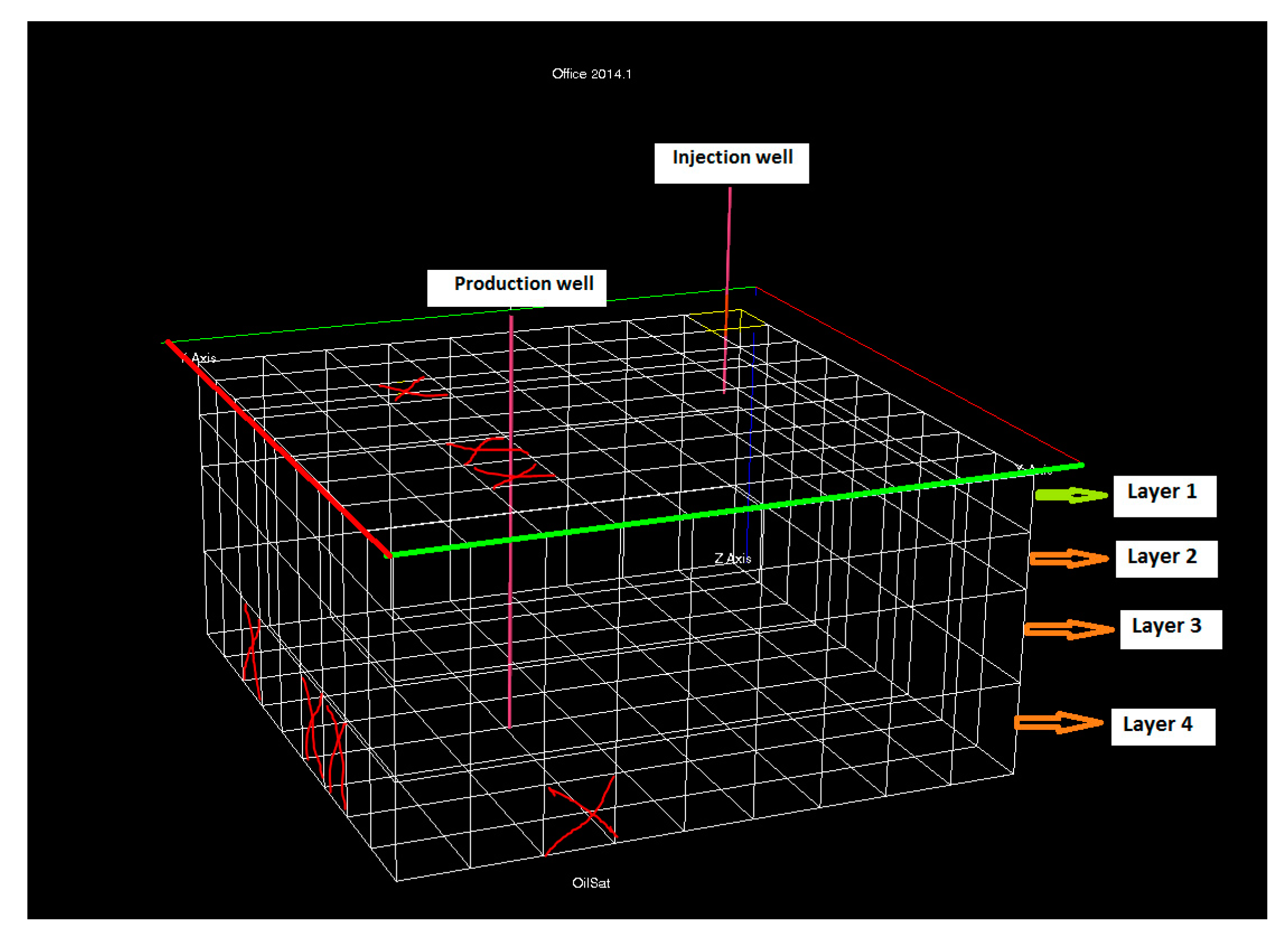
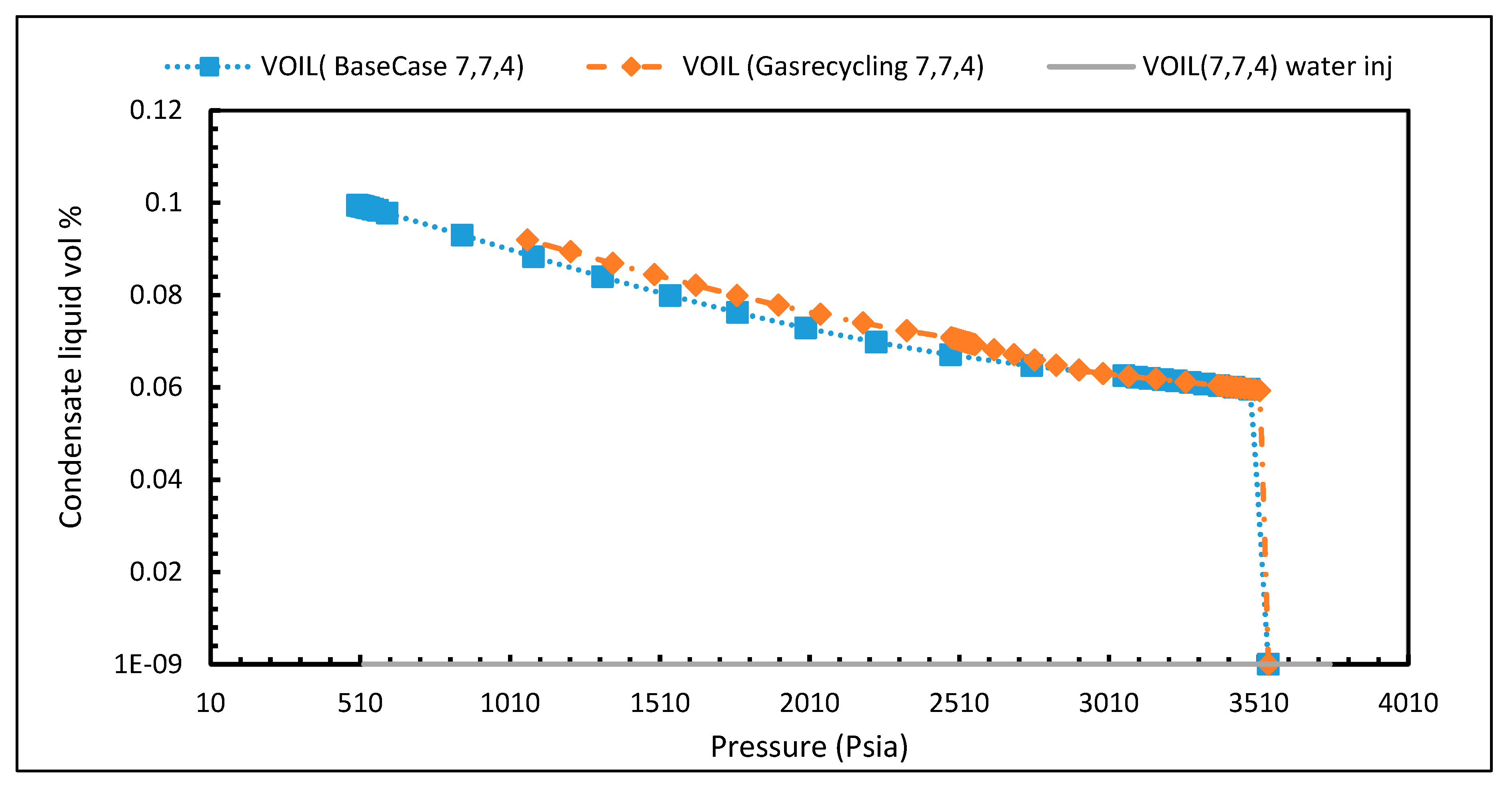
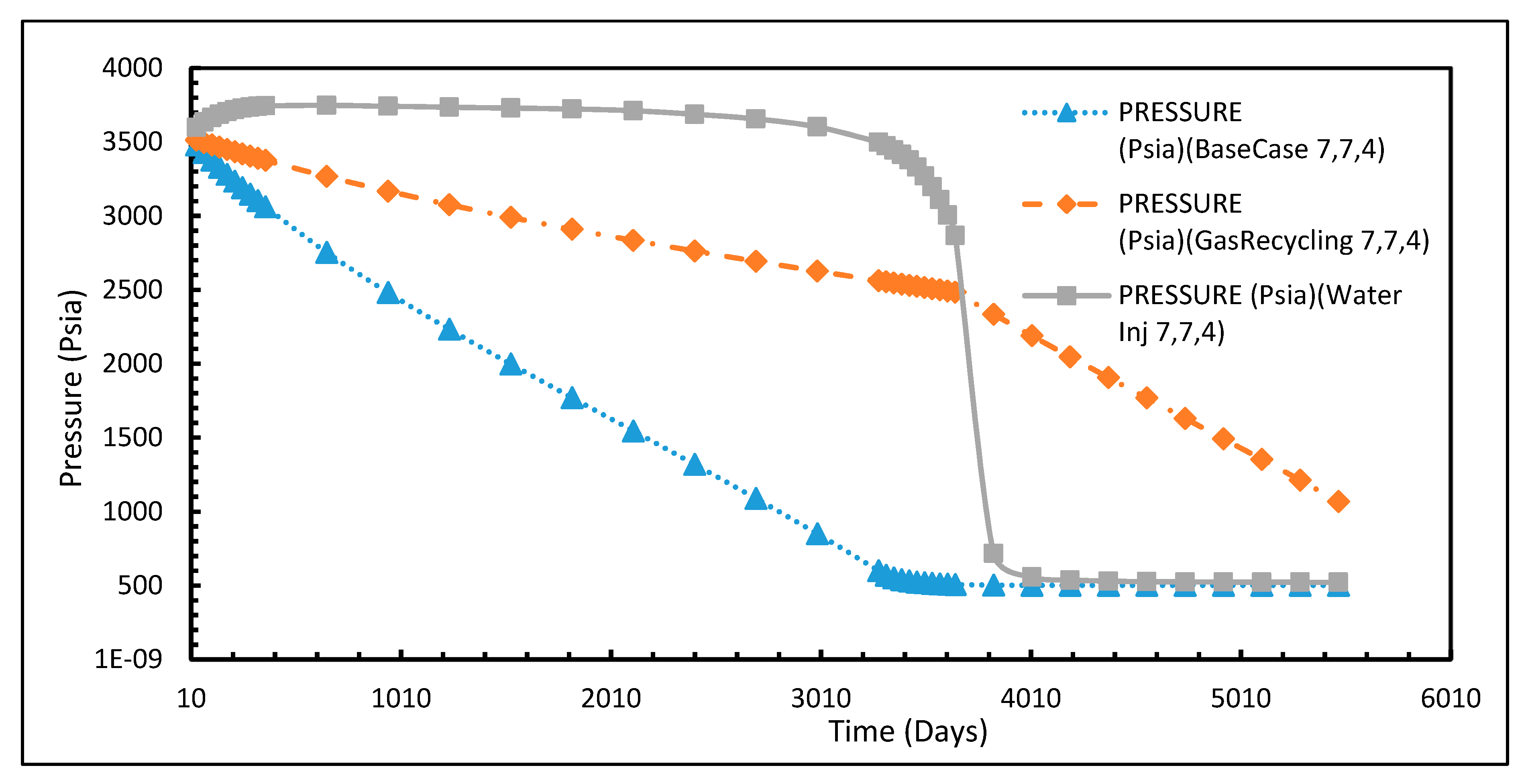
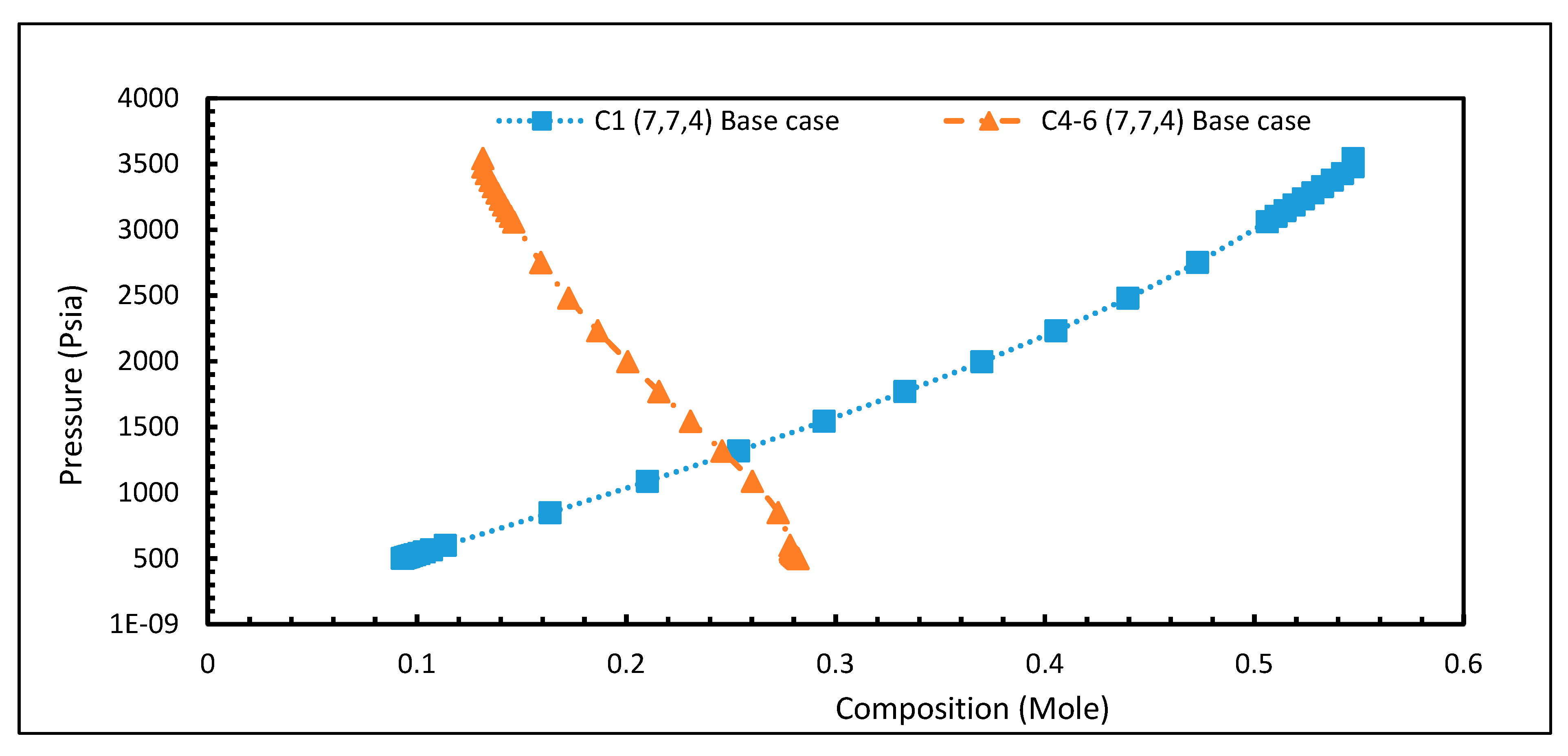
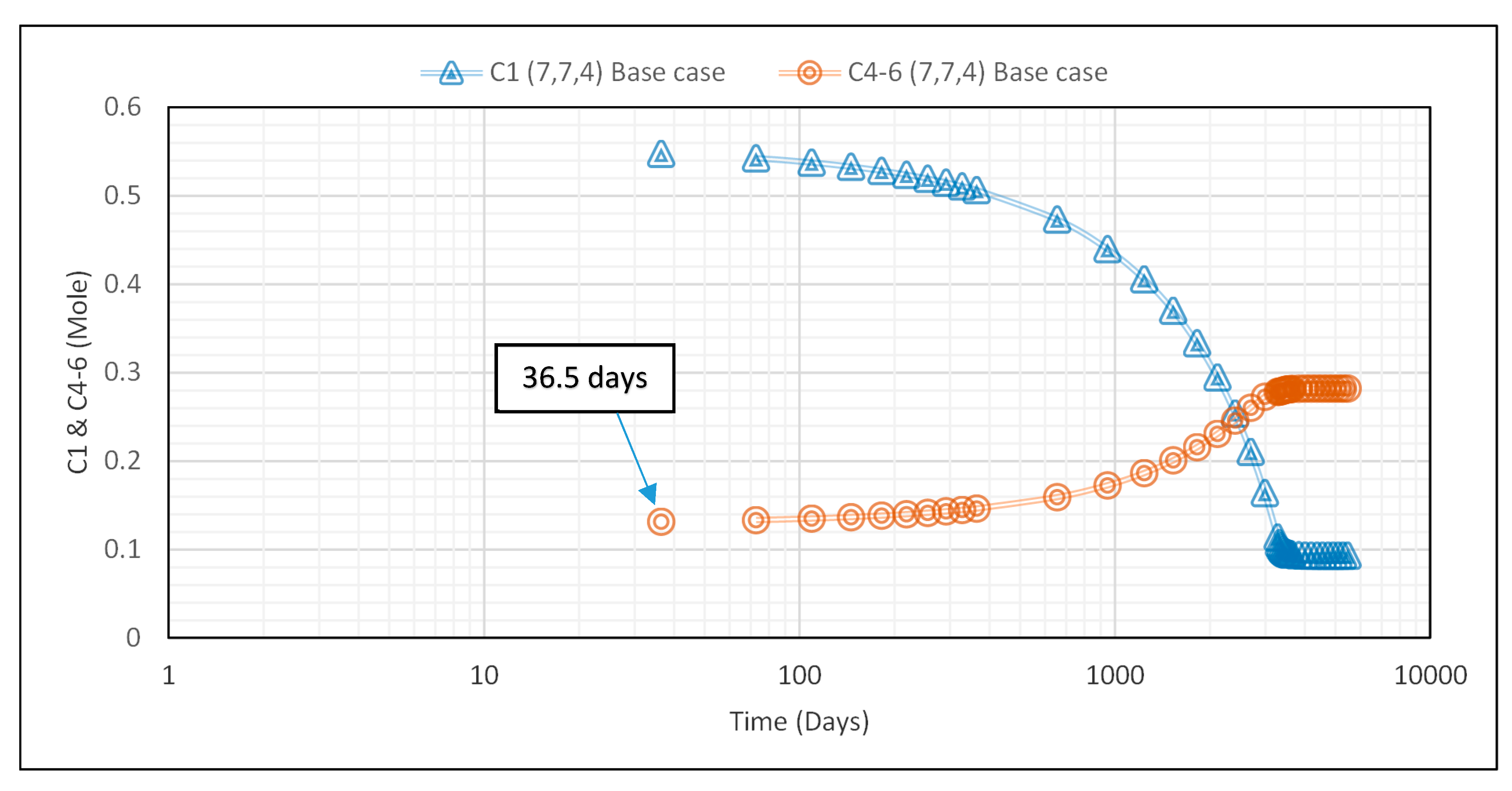
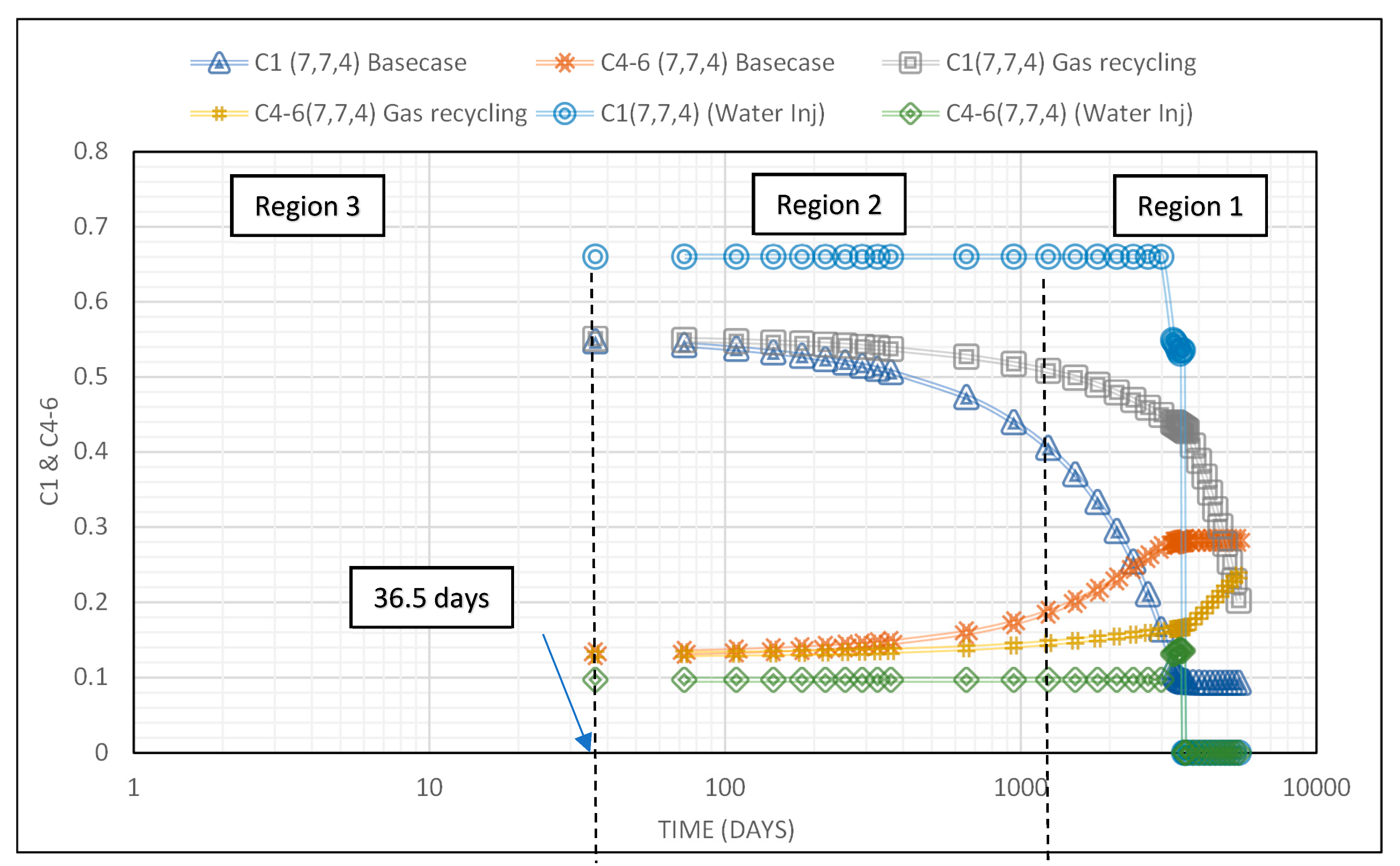
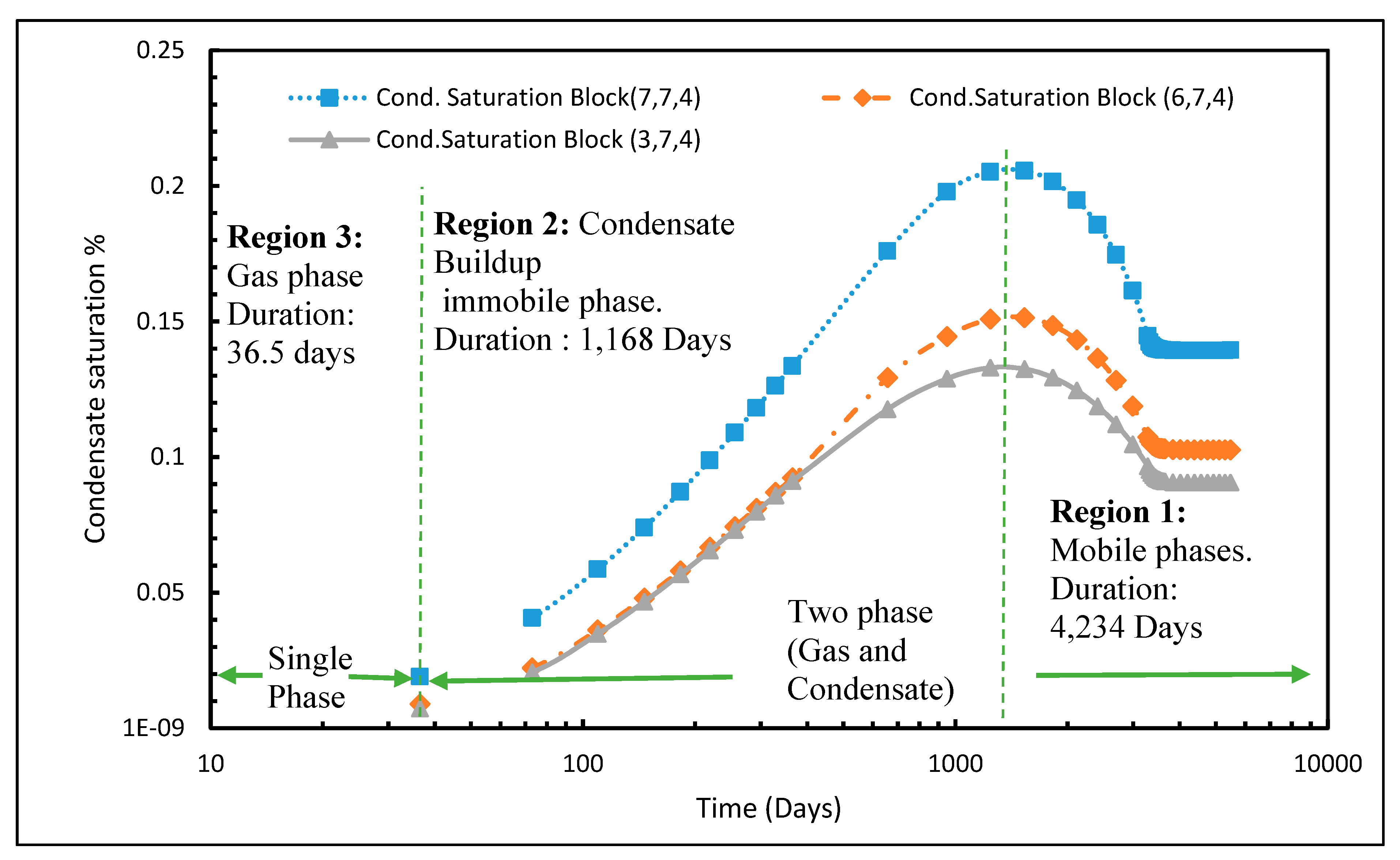
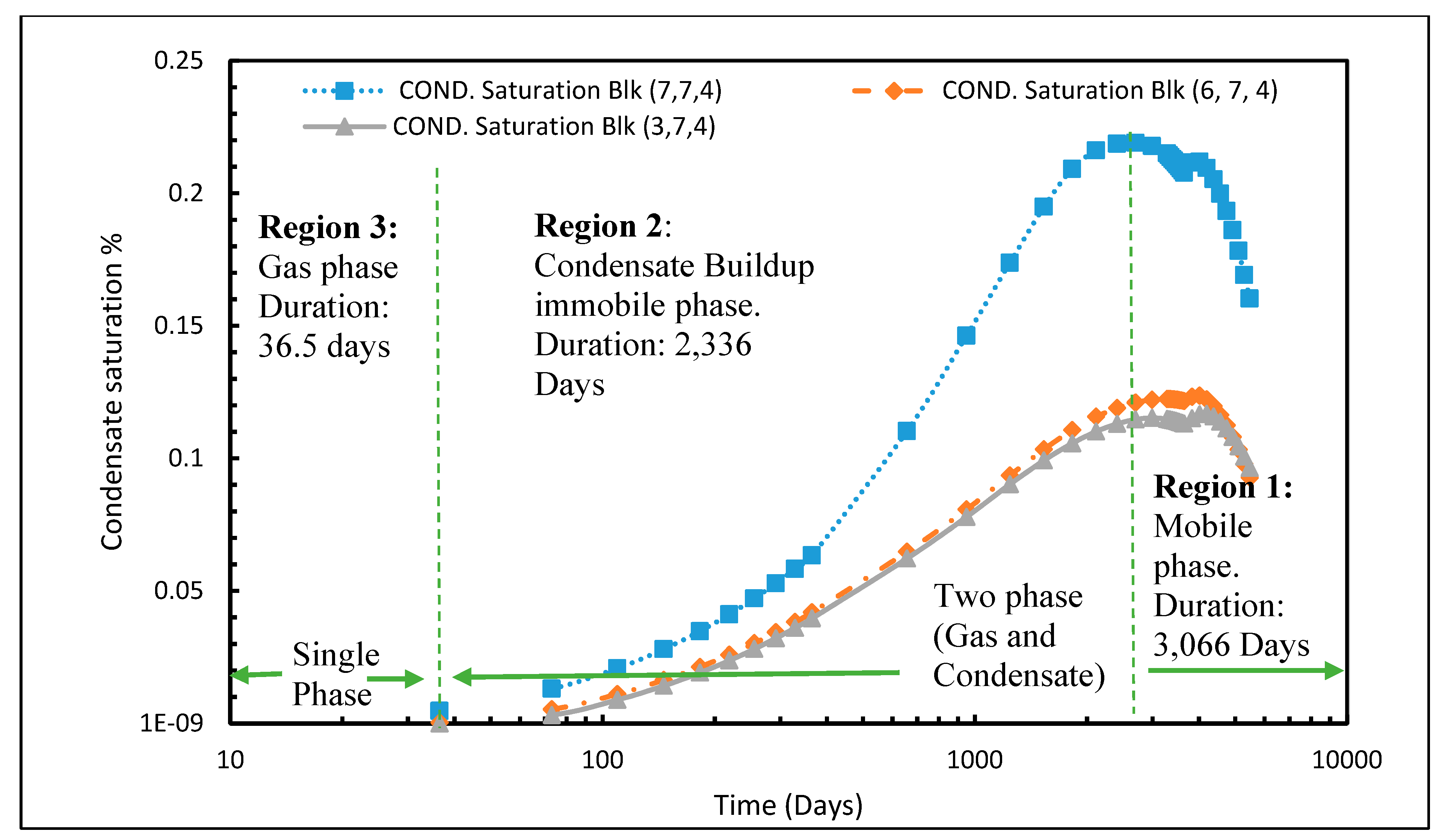
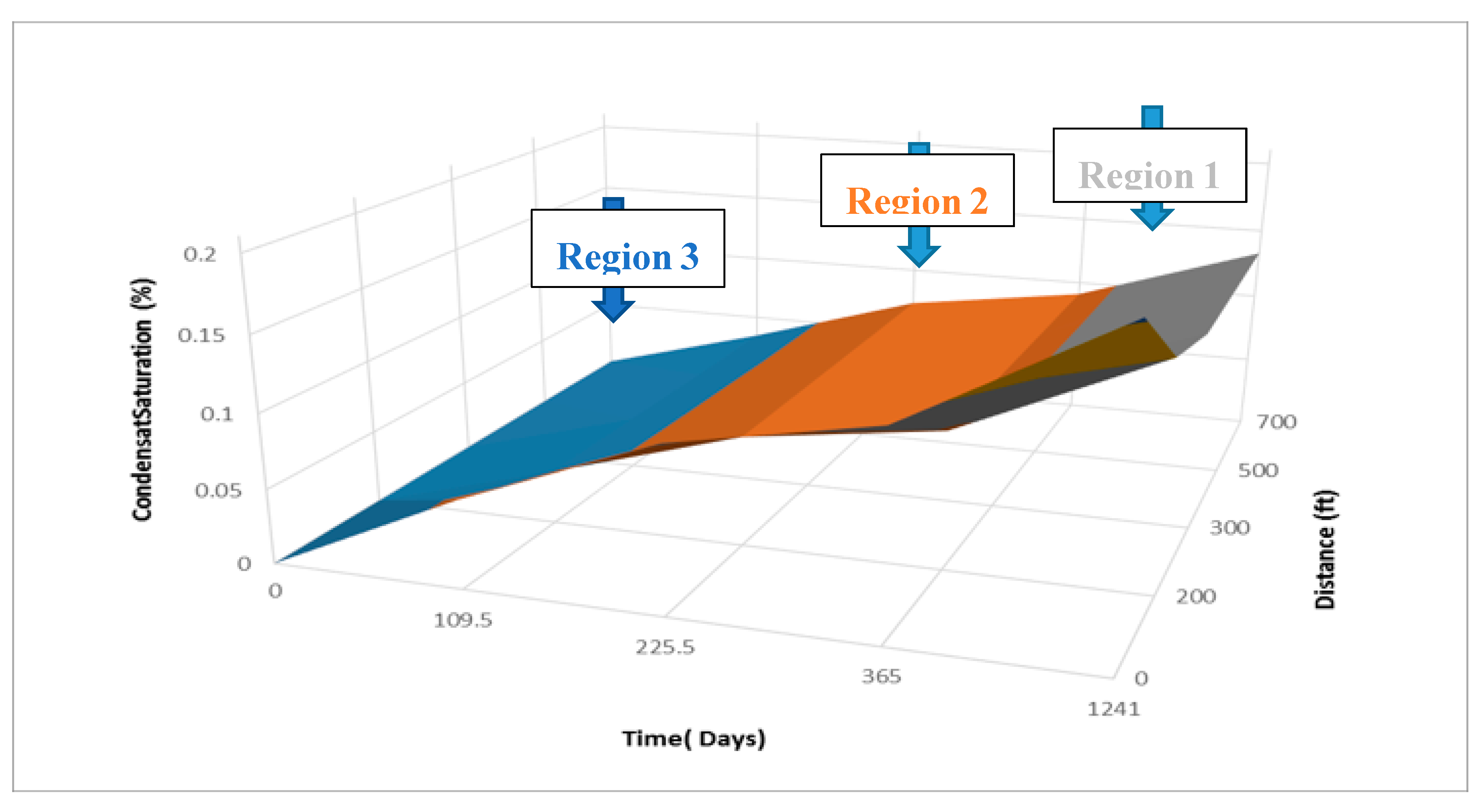
| Number of Cells | |
| X Direction | 9 |
| Y direction | 9 |
| Z-direction | 4 |
| Thickness, ft. | |
| DX = DY | 293 |
| DZ1 | 30 |
| DZ2 | 30 |
| DZ3 | 50 |
| DZ4 | 50 |
| Datum (subsurface), ft | 7500 |
| Rock Properties | |
| Porosity at initial Reservoir Pressure % | 0.13 |
| Permeability, (md) | 100 |
| Water Properties | |
| Water Saturation at contact | 1 |
| Gas/Water Contact, ft | 7500 |
| Density at contact, Ibm/ft3 | 63.0 |
| Compressibility, psi-1 | 3.0 × 10−6 |
| PV Compressibility, psi-1 | 4.0 × 10−6 |
| Initial Conditions | |
| Initial pressure, psia | 3550 |
| Dewpoint pressure, psia | 3428 |
| Initial Reservoir Temperature o F | 200 |
| Molecular Weight of C7+ | 140 |
| API Gravity | 51.4 |
| Well Date and Control Data | |
| Production well Data | |
| Position | I = 7, J = 7 |
| Perforation | K = 3 & 4 |
| Well Radius, ft | 1 |
| Minimum Bottom Hole Pressure, psia | 500 |
| Production Gas Rate, Mscf/d | 6200 |
| Injection Well | |
| Position | I = 1, J = 1 |
| Perforation | K = 1 & 2 |
| Well Radius, ft | 1 |
| Maximum Bottom Hole Pressure, psi | 4000 |
| Simulation Period, Days | 5475 |
| S/N | Fluid Components | Mole (%) |
|---|---|---|
| 1 | CO2 | 1.21 |
| 2 | N2 | 1.94 |
| 3 | C1 | 65.99 |
| 4 | C2 | 8.69 |
| 5 | C3 | 5.91 |
| 6 | iC4 | 2.39 |
| 7 | nC4 | 2.78 |
| 8 | iC5 | 1.57 |
| 9 | nC5 | 1.12 |
| 10 | C6 | 1.81 |
| 11 | C7+ | 6.59 |
| Total | 100 |
© 2019 by the authors. Licensee MDPI, Basel, Switzerland. This article is an open access article distributed under the terms and conditions of the Creative Commons Attribution (CC BY) license (http://creativecommons.org/licenses/by/4.0/).
Share and Cite
Bilotu Onoabhagbe, B.; Rezaei Gomari, S.; Russell, P.; Ugwu, J.; Ubogu, B.T. Phase Change Tracking Approach to Predict Timing of Condensate Formation and Its Distance from the Wellbore in Gas Condensate Reservoirs. Fluids 2019, 4, 71. https://doi.org/10.3390/fluids4020071
Bilotu Onoabhagbe B, Rezaei Gomari S, Russell P, Ugwu J, Ubogu BT. Phase Change Tracking Approach to Predict Timing of Condensate Formation and Its Distance from the Wellbore in Gas Condensate Reservoirs. Fluids. 2019; 4(2):71. https://doi.org/10.3390/fluids4020071
Chicago/Turabian StyleBilotu Onoabhagbe, Benedicta, Sina Rezaei Gomari, Paul Russell, Johnson Ugwu, and Blessing Tosin Ubogu. 2019. "Phase Change Tracking Approach to Predict Timing of Condensate Formation and Its Distance from the Wellbore in Gas Condensate Reservoirs" Fluids 4, no. 2: 71. https://doi.org/10.3390/fluids4020071
APA StyleBilotu Onoabhagbe, B., Rezaei Gomari, S., Russell, P., Ugwu, J., & Ubogu, B. T. (2019). Phase Change Tracking Approach to Predict Timing of Condensate Formation and Its Distance from the Wellbore in Gas Condensate Reservoirs. Fluids, 4(2), 71. https://doi.org/10.3390/fluids4020071






